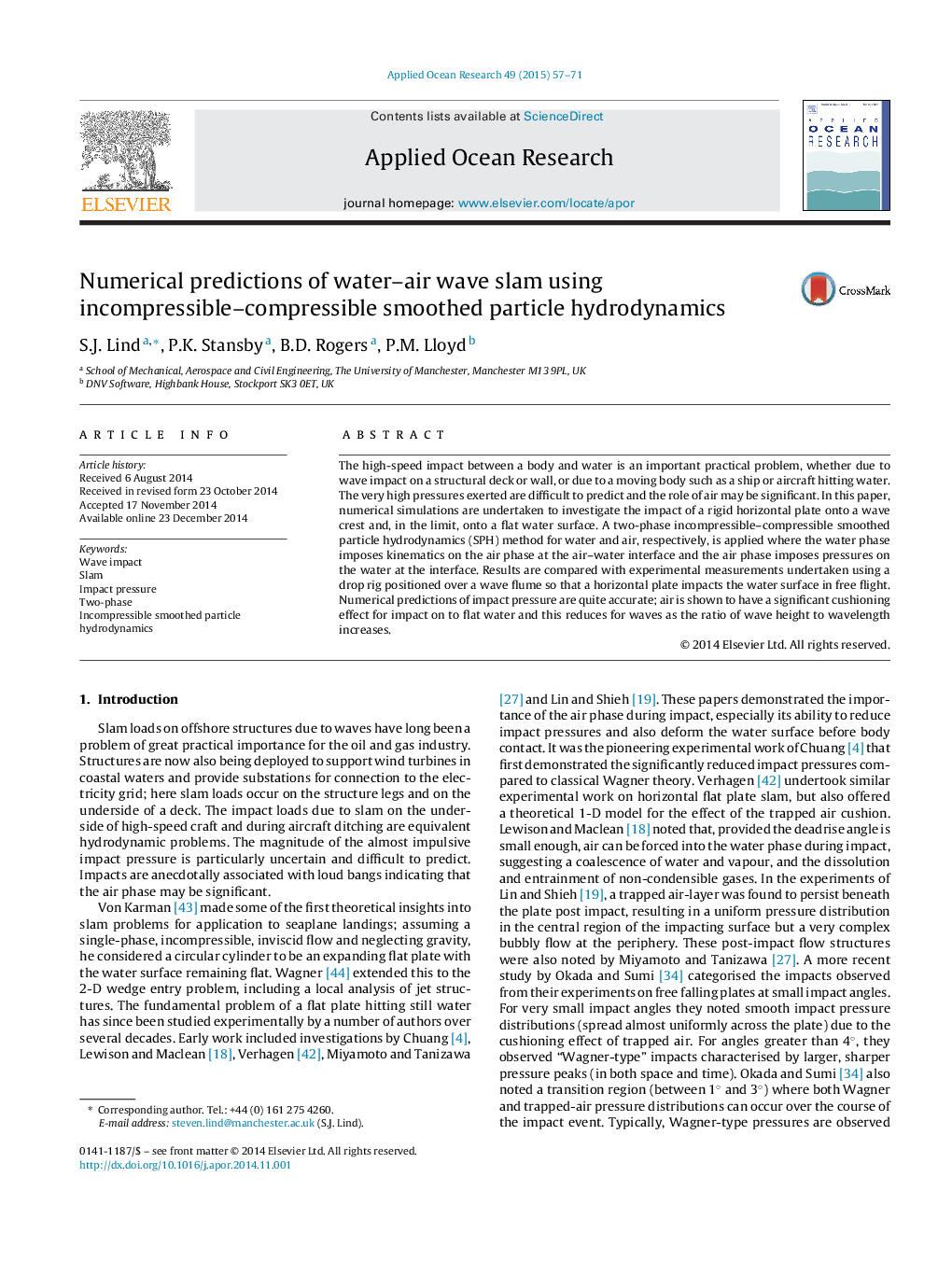| کد مقاله | کد نشریه | سال انتشار | مقاله انگلیسی | نسخه تمام متن |
|---|---|---|---|---|
| 8059389 | 1520254 | 2015 | 15 صفحه PDF | دانلود رایگان |
عنوان انگلیسی مقاله ISI
Numerical predictions of water-air wave slam using incompressible-compressible smoothed particle hydrodynamics
ترجمه فارسی عنوان
پیش بینی های عددی از موج آب-هوا با استفاده از هیدرودینامیک ذرات نرم شده با فشردگی سازگار است
دانلود مقاله + سفارش ترجمه
دانلود مقاله ISI انگلیسی
رایگان برای ایرانیان
کلمات کلیدی
تاثیر موج، اسلم فشار ضربه، دو مرحله ای هیدرودینامیک ذرات صاف ناپایدار،
ترجمه چکیده
تأثیر سرعت بالا بین بدن و آب یک مشکل مهم عملی است، چه به علت تاثیر موج در عرشه ساخت و ساز یا دیوار، و یا به دلیل یک بدن متحرک مانند یک کشتی یا هواپیما به آب ضربه. فشارهای بسیار زیاد برای پیش بینی دشوار است و ممکن است نقش هوا قابل توجه باشد. در این مقاله شبیه سازی های عددی برای بررسی تاثیر یک صفحه افقی سفت و سخت بر روی یک موج و در حد آن بر روی سطح آب تخت انجام شده است. بدین ترتیب یک روش هیدرودینامیکی ذرات ناپایدار با فشردگی دو فاز برای آب و هوا به کار می رود، در حالیکه فاز آب باعث ایجاد سینماتیک در فاز هوا در رابطۀ هوا-آب می شود و فاز هوا فشار آب را در رابط. نتایج با مقادیر آزمایشی انجام شده با استفاده از قطره ای که روی یک موج قرار می گیرند مقایسه می شود به طوری که یک صفحه افقی سطح آب را در پرواز آزاد تاثیر می گذارد. پیش بینی های عددی فشار ضربه بسیار دقیق است؛ هوا نشان داده شده است که یک اثر تقویت کننده قابل توجهی برای تاثیر بر روی آب صاف و این برای امواج کاهش می یابد به عنوان نسبت ارتفاع موج به طول موج افزایش می یابد.
موضوعات مرتبط
مهندسی و علوم پایه
سایر رشته های مهندسی
مهندسی دریا (اقیانوس)
چکیده انگلیسی
The high-speed impact between a body and water is an important practical problem, whether due to wave impact on a structural deck or wall, or due to a moving body such as a ship or aircraft hitting water. The very high pressures exerted are difficult to predict and the role of air may be significant. In this paper, numerical simulations are undertaken to investigate the impact of a rigid horizontal plate onto a wave crest and, in the limit, onto a flat water surface. A two-phase incompressible-compressible smoothed particle hydrodynamics (SPH) method for water and air, respectively, is applied where the water phase imposes kinematics on the air phase at the air-water interface and the air phase imposes pressures on the water at the interface. Results are compared with experimental measurements undertaken using a drop rig positioned over a wave flume so that a horizontal plate impacts the water surface in free flight. Numerical predictions of impact pressure are quite accurate; air is shown to have a significant cushioning effect for impact on to flat water and this reduces for waves as the ratio of wave height to wavelength increases.
ناشر
Database: Elsevier - ScienceDirect (ساینس دایرکت)
Journal: Applied Ocean Research - Volume 49, January 2015, Pages 57-71
Journal: Applied Ocean Research - Volume 49, January 2015, Pages 57-71
نویسندگان
S.J. Lind, P.K. Stansby, B.D. Rogers, P.M. Lloyd,
